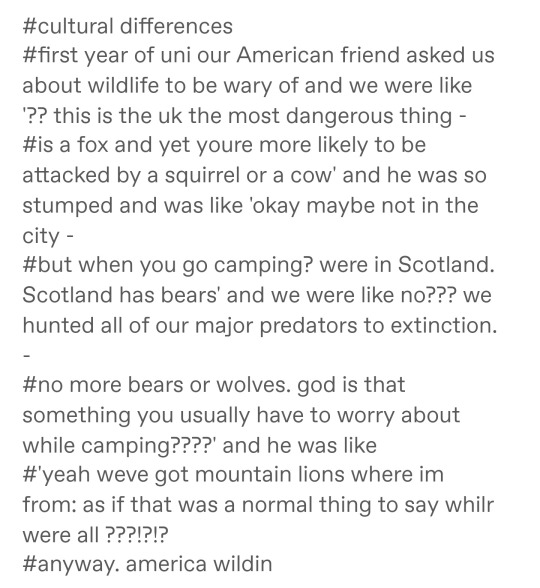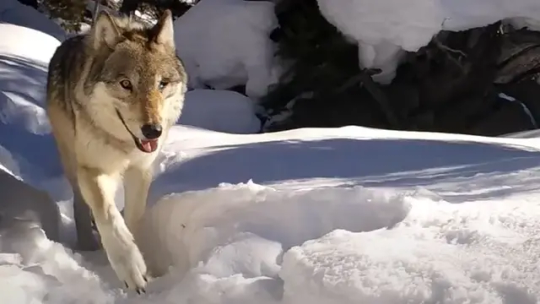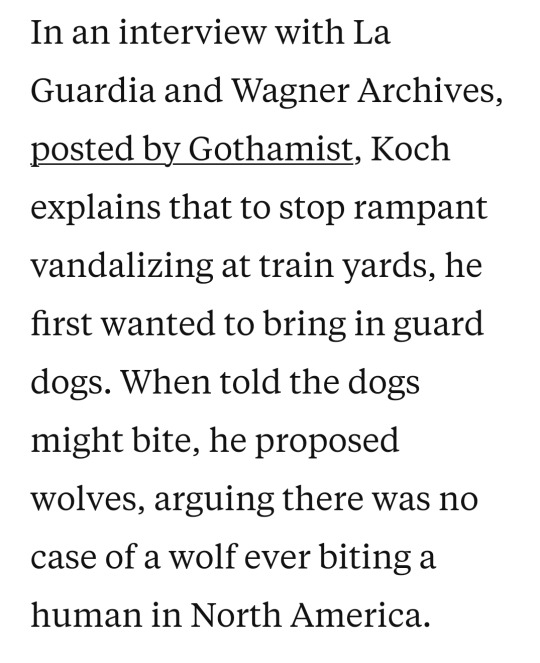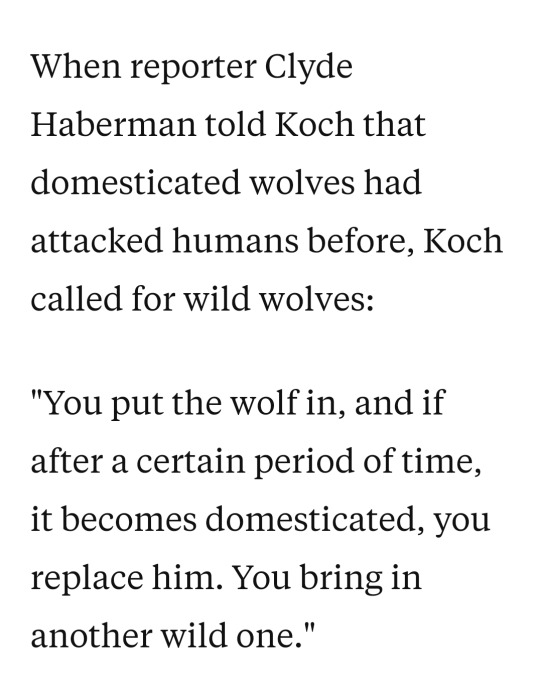#reintroduced wolves
Explore tagged Tumblr posts
Text
this may be a controversial opinion but i could not give less of a shit about the reintroduced colorado wolves killing livestock. if a wolf can get in and kill your livestock so easily then your livestock aren't protected.
#livestock#reintroduction#reintroduced wolves#wolf#wolves#conservation#farming#colorado#oregon#colorado wolves#Colorado Parks and Wildlife#animals#matt speaks
34 notes
·
View notes
Text

every time I'm made to hear about those shark rookies it's just always a story identical to this reworded in different ways
#i am unfortunately to w*llm/ck what destiel shippers are to buddie#but i do appreciate whatever is going on there. in the same way one gets to appreciate wolves being reintroduced into nature—#—in different states. where it's like. oh this is wonderful for the ecosystem. yayyyyyy. and then u dont think about it again#kiers.txt
9 notes
·
View notes
Text
was watching springwatch last night and there was a rly cool thing about the capercaillies and trying to help them repopulate via providing carcasses for the pine martens (who were successfully reintroduced) so that they'll eat that and not the capercaillie eggs. and thats very very cool if itll work. also 3 birds 1 stone, because you can use the invasive deer for food, feed the pine martens, and protect capercaillie nests all in one
#i say this knowing pine martens dont eat a huge amount of deers but still. one down. 10000000 to go lol#like and subscribe to kill an overpopulated invasive deer#i hope so bad wolves or lynx get reintroduced because the deer need to be dealt with so bad. aspens are getting eaten !!!#the wolves or lynx (any predators) are good not only for eating the deer but also to keep them moving so they cant just sit in one place#and breed and breed and ravage the native plants#if deer population got under control it'd help restore native scottish habitats .#fuck you england fuck you rich people for destroying the landscape for sport hunting. im going to get you#kiddo say#i saw a pinemarten irl once it was rly cool#watched it for quite a long time
34 notes
·
View notes
Text

@thepinkestpug the worst fuckin double date ever depending on who you ask (Fagin)
#cuppysketch#you can chart my progress like you can chart the deer population when wolves are reintroduced for my style as a bara artist#by just lookikg at how I draw Sykes
20 notes
·
View notes
Text
I absolutely love reading about rewilding efforts particularly when it comes to animals but god whenever I read about those ideas to re-introduce elephants and hyenas to Europe and cheetahs to North America "because their ancestors once lived there and it would be good for the ecosystem" I still get a little bit of whiplash.
#tekst#animal talk#im not inherently against it but it's just so weird to imagine living in the netherlands and having elephants and hyenas roam around#we cant even handle wolves how do you think people would react if we were to put those two species here#like the nonfiction books i read have plenty justifications why they think this could work but even they admit the idea is pretty radical#this isn't just your average 'reintroduce wolves or wisents'
3 notes
·
View notes
Text
Holding the Scottish rewilding community's faces with both hands and asking them if they've even read Wolves of Willoughby Chase
#'we NEED to reintroduce large predators' look I get it I get where you come from also maybe no a lttle bit maybe no#IT'S LIKE THEY HAVEN'T EVEN READ WOLVES OF WILLOUGHBY CHASE
11 notes
·
View notes
Text

"The wolves did not do this." Ever since reintroducing the species to Colorado, the townsfolk had been upset, to say the least. "Someone's made it look like it was, but it wasn't. I've been following these animals since day one. Hell, I've known most of them since they were born. It. Wasn't. Them." Sloane is angry. She's trying to keep herself under control, but it's hard with fingers being pointed at the innocent. Her breathing is rapid and she can feel her face heating up. If he said one more thing to upset her... // @memxntovivere
#sloane perry / threads.#be prepared for a shit ton of threads bestie!#she's a biologist#specializing in wolves and reintroducing them to certain areas of the world
1 note
·
View note
Text
I know we all want jurassic park or whatever the hell sure it's fun as a fictional thought piece but please consider what introducing one (1) foreign species into a new environment can do to said environment and what kind of impact it will also have on the animal itself
#i mean look at literally any invasive species like the ball pythons in florida or lionfish#its like. these are bad#and were introduced into these environments without thought or care and now theyre a Huge Problem#it's different for species that are Reintroduced back into their native environments like the wolves in yellowstone or wherever that was#because we already Know theyre supposed to be there#but when you take an Extinct animal#theres uh. no where it belongs now!#it died! its gone! the environments have moved beyond them#unless its super recently extinct theres like. no ethical way we could do it#without potentially having Severe unforseen ramifications
1 note
·
View note
Text
Hush! Video of Colorado's reintroduced wolves' pups playing
35K notes
·
View notes
Text
I'm pretty sure they don't even eat the grouse they're just shooting things for shits and giggles

Actually your society is the freaks for shooting everything that moves and burning half your "nature reserves" every year so that upperclass dandies can eat leaded pheasant. North Americans are the well adjusted ones here, your country has become a desolate suburban lawn in island form
#i make fun of americans too#but they are correct on this one#there are plans to reintroduce wolves and things to scotland
99K notes
·
View notes
Text
Reintroducing Wolves to Scottish Highlands Could Boost Woodlands, Study Finds
A wolf at Highland Wildlife Park near Kingussie, Scotland on Dec. 31, 2008. Peter Hopper / Flickr Why you can trust us Founded in 2005 as an Ohio-based environmental newspaper, EcoWatch is a digital platform dedicated to publishing quality, science-based content on environmental issues, causes, and solutions. The reintroduction of wolves to the Scottish Highlands could help expand native…

View On WordPress
0 notes
Text
'She is so old': One-eyed wolf in Yellowstone defies odds by having 10th litter of pups in 11 years
By Patrick Pester, published June 3, 2024
Wolf 907F recently gave birth to her 10th litter of pups, which researchers say is likely a Yellowstone National Park record.

Wolf 907F walking past a trail camera in Yellowstone National Park. (Image credit: Yellowstone Wolf and Cougar Project)
The alpha female of a Yellowstone gray-wolf pack has defied the odds by having a 10th litter of pups at the age of 11.
The one-eyed wolf elder, named Wolf 907F, gave birth to her latest litter last month, the Cowboy State Daily reported. Gray wolves (Canis lupus) have an average life span of three to four years, so it's rare for them to reach 11, let alone have pups at that age.
Wolf 907F has given birth to pups every year for a decade straight since she became sexually mature, which Kira Cassidy, a research associate at the Yellowstone Wolf Project, said is likely a record for the wolves of Yellowstone National Park.

At age 11, Yellowstone’s Wolf 907F has lived more than twice a wild wolf’s average life expectancy. In this photo from April, she was pregnant with a litter of pups that she’s since given birth to. (Courtesy Yellowstone Wildlife Project)
"Every day, I expect that she might die just because she is so elderly, but I've been thinking that for the last few years, and she keeps going," Cassidy told Live Science.
Cassidy has calculated that only about 1 in 250 wolves in Yellowstone make it to their 11th birthday, with just six recorded examples since wolves were reintroduced to the park in 1995. The oldest of all of these great elders lived to 12.5 years, according to the National Park Service.

Wolf 907F lies in the snow in Yellowstone in 2015. (Image credit: Kira Cassidy/NPS)
Wolf 907F is the oldest wolf to have lived her whole life in the park's Northern Range, where there is more prey but also more competition from other wolves. Wolves rarely die of old age in the wild, and in Yellowstone National Park, the biggest threat is other wolves.
"In a protected place like Yellowstone, their number-one cause of death is when two packs fight with each other," Cassidy said. "That accounts for about half of the mortality."

One of Yellowstone's oldest wolves, Wolf 907F is pictured here with her pack last year. She's the gray collared wolf on the lower left. (Courtesy Yellowstone Wildlife Project)
Wolf 907F is the alpha female of the Junction Butte pack, which has between 10 and 35 members at any given time. Cassidy noted that this is a large pack — the average wolf pack size is about 12 individuals — and that reduces the risk of being killed in territorial fights. Wolf 907F's experience also gives her pack an edge.
"Packs that have elderly wolves are much more successful in those pack-versus-pack conflicts because of the accumulated knowledge and the experience that they bring to that really stressful situation," Cassidy said.
Wolf 907F has likely boosted her pack's survival chances outside of battle, too. Cassidy noted that the Junction Butte pack rarely leaves Yellowstone's border and that Wolf 907F is "savvy" when it comes to things like crossing roads and avoiding humans.

Wolf 907F, Yellowstone's aging matriarch at 11 years old, only has one eye. She's the fourth wolf to pass by this trail cam. (Courtesy Yellowstone Wildlife Project)
What makes Wolf 907F even more impressive is that she does all of this with only one functioning eye. Researchers aren't sure what happened, but her left eye has been small and sunken since before she turned 4. "You would never know [when] watching her," Cassidy said.
Like other elders, Wolf 907F takes a back seat in hunts now that she's older, and she spends most of her day hanging around with the pack's pups. Cassidy and her colleagues have counted three pups in her current litter, which is smaller than the average litter size of four to five but not surprising. A 2012 study of Yellowstone wolves published in the Journal of Animal Ecology found that litter size declines with age.
"The fact that 907 is still having pups is amazing, and her litter being small is expected given that she is so old," Cassidy said.
A few of Wolf 907F's offspring now lead packs of their own, but most of her pups never reach adulthood due to the perilous nature of being a wolf. However, Wolf 907F and the others in the park don't seem to live like death is on their mind.
"They are happy to be with their family going from day to day," Cassidy said. "Even if they have injuries or are missing an eye or something really stressful is going on in their life, they move through that stress and go back to seemingly really enjoying their life."

At age 11, Yellowstone's Wolf 907F - the gray wolf in the center of this photo from 2020- has lived more than double the typical lifespan of wolves in the wild. (Courtesy Yellowstone Wildlife Project)
34K notes
·
View notes
Text
Colorado will capture 15 BC wolves to reintroduce the population to the state | CBC News
Colorado officials plan to capture up to 15 gray wolves from British Columbia’s interior to help the Centennial State restore the long-lost predator population. In a statement, Colorado Parks and Wildlife (CPW) said its experts began their non-lethal search on Friday in accordance with the British Columbia Ministry of Water, Land and Resource Management. Wolves historically inhabited Colorado,…
1 note
·
View note
Text

Bonus:




remember when this was the craziest thing politicians ever said
#given that the original article is from 2013#I'll just be over here rereading the Wolves of Willoughby Chase which is just nonstop consequences of accidentally reintroducing wolves
37K notes
·
View notes
Text
Wait the main Villain of Dragon Age now is just a #Landback emancipator of slaves functionally performing ecoterrorism on the bloated, death-spiralling colonial powers of 20th Century Christianity and I'm supposed to want to stop this guy?
#Veilguard#Like yeah sure he's gonna kill a lot of people in order to repair the damage they've done to the ecosystem#So what#I'd let the Ruhr Valley drown if it fixed climate change.#I'd reintroduce Super Wolves into the streets of Rome if it meant the end of Catholic Hegemony#Let me on his team I can fix him
1 note
·
View note
Text
I microdose on rage at work. I sit up to see over my computer where the TV playing fox news is and see whatever stupid ass shit they're spewing and the rage I feel helps keep me awake on these long nights
#ramblings from me#like theyre mad about the wolves being reintroduced.#theyre mad about trans people like all the fucking time#and apparently its now unamerican to have a fake christmas tree cause theyre all made in china#and i thought i got stupid ohone calls
0 notes